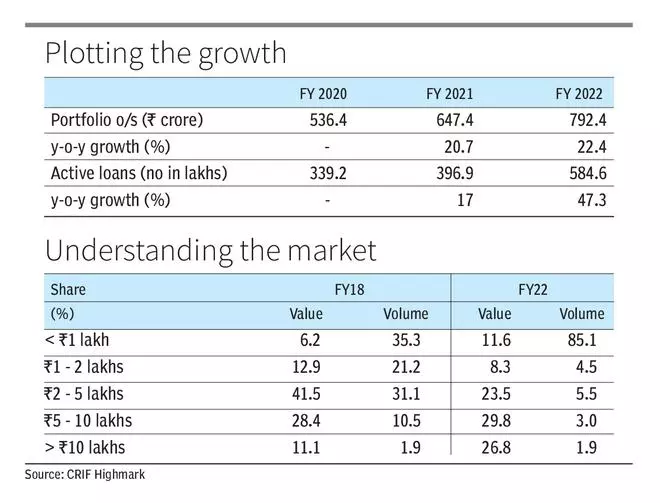Whether it was last year’s guidelines on how fintech can lend and more recently last Thursday’s announcement by the Reserve Bank Governor that pre-sanctioned credit limit can be accessed through UPI, it’s pointing out to two things. The regulator is committed to supporting financial inclusion and that should be propelled by regulated entities. Systemically, product innovation, trials and testing may be happening in the fintech world, but credit and credit deployment is channelised through regulated entities, with banks get priority over non-banks.
The move to allow users of UPI to access pre-approved loans can be a pathbreaking step towards formalising over two-thirds of the 30 million UPI user base to credit products.
How would it work?
According to NPCI, over 99 per cent of UPI users are linked to their bank accounts. Pre-sanctioned loans would be akin to personal loans where the end-use isn’t strictly defined. But instead of availing it through the bank’s website, it can be done through UPI. Also, for safety reasons, users with two or more bank accounts use accounts where high balances aren’t maintained for UPI transaction. Pre-sanctioned loans may tempt such users to widen their usage. But then, when the RBI allowed UPI users to access overdraft facilities, why this then? That’s because overdraft facility isn’t something banks hand out to all customers easily, whereas pre-sanctioned loans are widely available across all income segments.
Can UPI cannibalise credit cards, make debit cards more redundant, and is it formalised version of buy now pay later (BNPL)? Yes, to all.

The problem that RBI had with BNPL was that several entities which were not authorised to lend jumped into the lending arena. Given how the model started crumbling in the US and Australia by early 2021, RBI’s discomfort with the unstructured BNPL model is understandable. With pre-sanctioned loans, the bank based formulates and approved a credit limit against which money can be borrowed using the app. The difference between this and BNPL is that while availing loans through UPI there will be a cut-off limit. With BNPL, the limit depends on how is already spent.
As regards debit cards although the number of cards in force is larger compare to credit cards, as a business segment debit cards has been shrinking in terms of end-use right from when UPI was introduced. That may continue.
Is it a quasi-credit card product? A credit card can be swiped any number of times till the limit is reached. With pre-sanctioned loans it needs to be seen if banks would allow customers to dip into limits multiple times, because doing so may not be cost-effective for the bank. That said, for these pre-sanctioned loans to really snatch the share of credit cards, it’s important that they are priced very attractively, well below revolver rates of 36 – 48 per cent for credit cards. Nevertheless, it is not clear why the RBI chose to introduce pre-sanctioned loans on UPI when Rupay credit cards can be linked to UPI? Shouldn’t the ecosystem be expanded to all other cards before coming up with a new product?
Fixing the coupon
Pre-sanctioned loans by default means giving a customer a loan based on the credit history as assessed by the bank over the tenure of relationship between the bank and the customer. With UPI, if the objective is to extend these loans to new to bank or new to credit customers, it goes against the logic of pre-sanctioned loans. As such the share of personal loans, which accounts for 12 – 18 per cent of private banks’ retail portfolio is the one segment which has been growing faster than the average post- pandemic. While such personal loans tend to be high yielding, it’s also a highly risky product.
So far, banks have been able to keep a lid on delinquencies in this portfolio, because they extend these loans to their existing customers with whom they have some history either on the deposits or the loans business. If banks are to introduce these products to NTB or NTC segments without adequate analysis of the credit history, these loans have to be priced based on the customer and not on the product. In the current market conditions, across all retail products, banks are increasingly pricing the product and not the customer. Till now, with overall quality of borrowers and positioning of the products remaining steady, we’ve not faced any road bumps on the retail lending business. But with this product, it may be a bit of departure from some of the current practises that banks are adopting.
But then, the question which banks need to answer before introducing these pre-sanctioned loans is whether they are looking this credit product as a whole new market segment or an add-on to the existing play. If it is the latter, the risks seem manageable. But if pre-sanction loans through UPI should be the new competition, every part of the value chain, starting with underwriting to pricing and even the customer pool, could be a challenging task to manage.
History has taught us that every time a new product hits the market there is an irrational exuberance around it. This comes back to jeopardise the asset quality and the financials of the bank. Will banks be willing and ready to do what it takes to grab a pie of this upcoming market segment? That would depend on correctly identifying the problem that the RBI wants to solve.









Comments
Comments have to be in English, and in full sentences. They cannot be abusive or personal. Please abide by our community guidelines for posting your comments.
We have migrated to a new commenting platform. If you are already a registered user of TheHindu Businessline and logged in, you may continue to engage with our articles. If you do not have an account please register and login to post comments. Users can access their older comments by logging into their accounts on Vuukle.